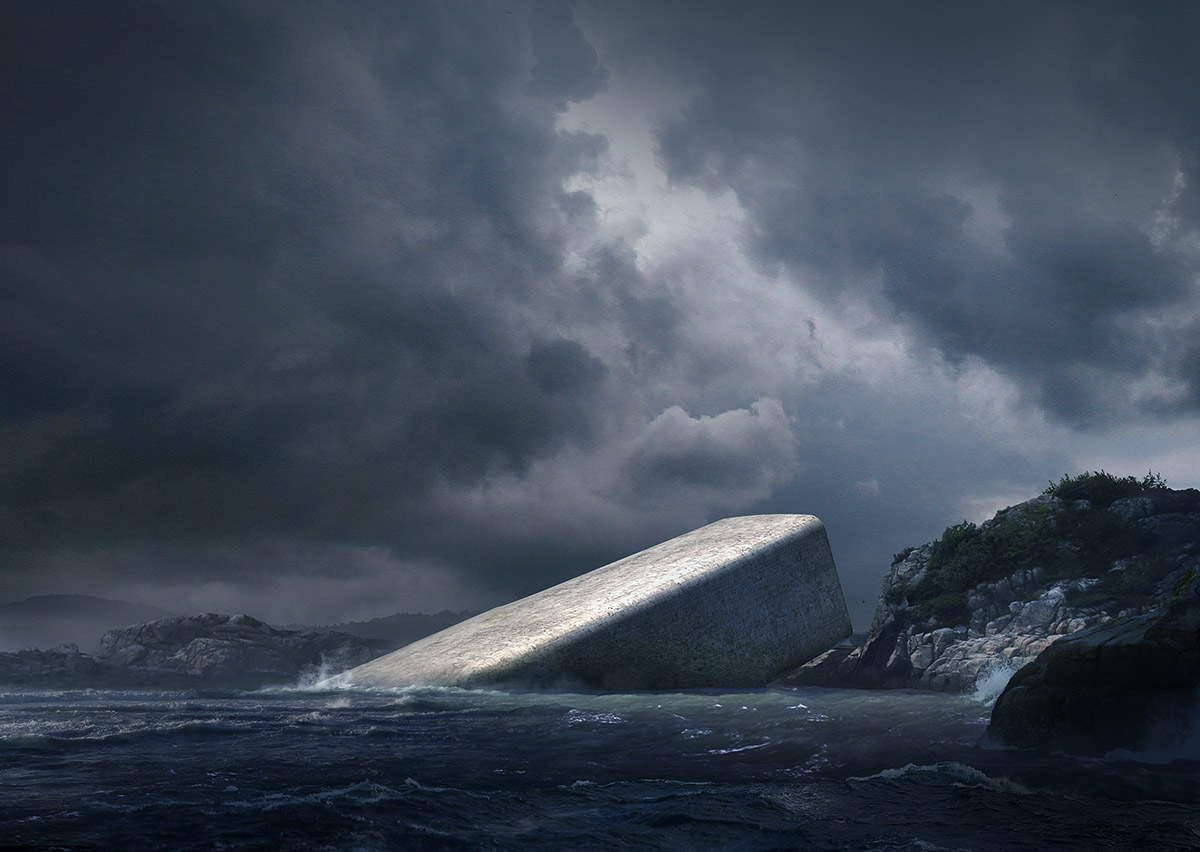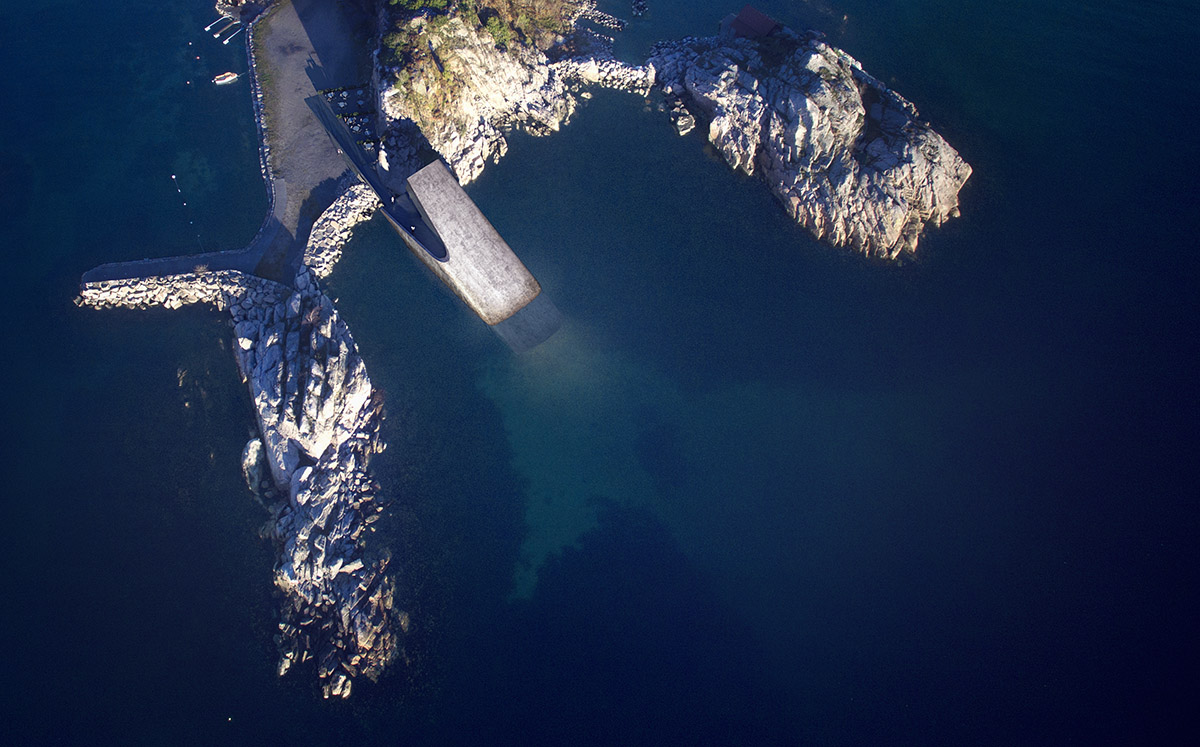Submitted by WA Contents
Snøhetta unveils plans for half-sunken rocky underwater restaurant in Norway
Norway Architecture News - Oct 24, 2017 - 14:29 14166 views

Norwegian architecture firm Snøhetta has unveiled plans for a half-sunken underwater restaurant and research center for marine life, which will be Europe’s first underwater restaurant. The rock-looking structure is located in the village of Båly, which takes place at the southernmost point of the Norwegian coastline.
Named Under, the monolithic restaurant creates immediate proximity with the forces of nature, which is also planned to function as a research center for marine life - is a tribute to the Norwegian coast and to Lindesnes – to the wild fauna of the sea and to the rocky coastline of Norway’s southern tip.
Snøhetta's monolithic form breaks the water surface to lie against the craggy shoreline. Acting like more than an aquarium, the structure will become a part of its marine environment, coming to rest directly on the sea bed five meters below the water’s surface.

This seemingly untouchable structure is made up of one-meter-tick walls and is built to withstand pressure and shock from the rugged sea conditions. Like a sunken periscope, the restaurant’s massive acrylic windows offer a view of the seabed as it changes throughout the seasons and varying weather conditions.
Snøhetta designed this concrete shell by considering the harsh climate conditions and other environmental issues - and specifically by considering its geographic context and aquatic neighbours - in order not to damage the structure.

"The sleek, streamlined form of the building is encapsulated in a concrete shell with a coarse surface that invites mussels to cling on. Over time, as the mollusk community densifies, the submerged monolith will become an artificial mussel reef that functions dually to rinse the sea and naturally attract more marine life to its purified waters," said Snøhetta.
"Muted lighting from the inside of the restaurant and installed on the seabed will help stage the wildlife flourishing on the sandbank outside the 11 x 4-meter panoramic acrylic window," added the studio.
Outside opening hours, parts of the restaurant will also be dedicated to a marine biology research center welcoming interdisciplinary research teams studying marine biology and fish behavior. Researchers from Norwegian research centers will among other seek to train wild fish with sound signals and will research whether fish behave differently throughout the shifting seasons. The researchers will also help create optimize conditions on the seabed so that fish and shellfish can thrive in proximity to the restaurant.
Informational plaques will be mounted alongside the trail leading guests to the restaurant entrance at the water’s edge. This informational path tells a story about marine biodiversity and the Norwegian coast, weaving the narrative of the site into the overall restaurant experience, and ends at a ramp up to the restaurant.

The entrance is clad in untreated, locally sourced oak that will eventually fade into grayish tones, harmonizing with the raw concrete. On a day of rough sea, you can feel a hint of fresh, salty ocean spray against your face as you enter the restaurant.
The building comfortably accommodates 80-100 guests. As visitors begin their journey through the restaurant they descend through three levels. From the entrance, where the tidepool is swallowed by the sea, guests enter the wardrobe area. Visitors are then ushered down one level to the champagne bar, which marks the transition between the shoreline and the ocean.
This physical transformation is emphasized by a narrow acrylic window cutting vertically down through the restaurant levels. From the bar, guests can also look down at the seabed level of the restaurant, where two long dining tables and several smaller tables are placed in front of the large panoramic window.
"The restaurant's color palette follows the logic of the different stories of the construction. While the champagne bar is characterized by colors inspired by the coastal zone, with its subdued colors evoking the sediment of shells, rocks and sand, the dining room is submerged in darker blue and green colors inspired by the seabed, seaweed and rough sea," explained Snøhetta.
"The warm oak of the restaurant interior contrasts with the rough concrete shell, creating an intimate atmosphere. Materials are chosen not only for their aesthetic qualities, but also for their sustainable characteristics and ability to create a good indoor climate. Advanced heating pump technology that utilizes the stable seabed temperature functions to heat and cool the building year-round," the architects added.

Through its architecture, menu and mission of informing the public about the biodiversity of the sea, Under will provide an under-water experience inspiring a sense of awe and delight, activating all the senses – both physical and intellectual.
Snøhetta recently completed new Art School in Bergen, which features a strong metallic effect on its facade and plays with solid-void relationships to create a sense of depth. The studio also unveiled plans for the transformation of a 150-year inaccessible industrial region of North America - Willamette Falls - to revive the area with new river walks and public spaces overlooking Oregon City's waterfront.
Snøhetta's another eagerly anticipated building King Abdulaziz Centre for World Culture, made of soft pebbles with clad in stainless steel tubes, is nearing completion in Dhahran, Saudi Arabia.
All images © MIR and Snøhetta
> via Snøhetta
